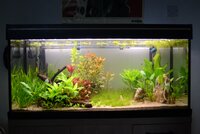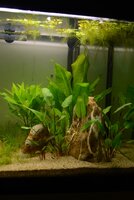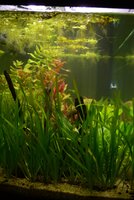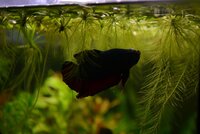My initial plan had been to document the use of the EI dosing method in my CO2 dosed tank. However, after the negative experience I had recently using CO2 I’m not ready to set up another high tech system so I’m going to give the low tech dirt tank system a go. I’ll attempt to document the set up and development of the tank in this journal and share my experiences, both positive and negative, on the forum. This will be good learning for me (and maybe useful for other people) as I’ll be keeping a record of everything I do and this will hopefully make solving the inevitable problems easier – especially with the help and advice of everyone on these forums.
As I lost all my livestock in my previous set up, I completely stripped down my tank and cleaned everything thoroughly. A blank canvas…………….
I will be working towards establishing a low maintenance system incorporating some of the ideas on this forum (especially from Troi’s post), Diana Walstad (I’ve just read her excellent book – Ecology of the Planted Aquarium) and Tom Barr’s EI dosing method.
Aquarium Parameters
Volume: 150 litres (~ 40 US gallons)
Temperature: 22degC – Lower temp should increase CO2 solubility
Filtration: 1 x external filter (Aquamanta EFX200)
Lighting: 2 x T5 HO 39W without reflectors
Photoperiod: 4.5-3-4.5 siesta regime (4.5 hours on - 3 hours off - 4.5 hours on).
Substrate: Westland top soil : John Innes No3 – 2:1 ratio topped with Unipac sand. The soil layer is approx 1 in deep and the sand layer is approx 0.5 – 1 in deep.
Fertiliser: Low tech EI
Here's the soil I used
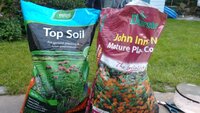
Aquarium Maintenance
My plan is to change approximately 20% of the water every month. I will set this water at a specific GH and alkalinity (more on that below)
Tap Water Quality
I live in Sheffield and we have very soft water with a low nitrate concentration.
pH 7 - 8
Calcium 5.45 ppm
Magnesium 2.4 ppm
Sodium 28.2 ppm
Iron 20 ppb
Nitrate 2.2 ppm
Nitrite 9 ppb
Copper 20 ppb
Sulphate 52 ppm
Total Hardness 9.5 ppm
As you can see from the figures the total hardness is 9.5 ppm (~1.3 dGH) which means the water is very soft and has low carbonate buffering capacity. In my previous set up I did notice melting in some of the plant species and I think this may have been partially attributable to the fact that the levels of Ca and Mg were very low – I also think I was starving the plants.
I will adjust the GH of the water by approximately 6 dGH using a mixture of calcium chloride and magnesium sulphate in a 4:1 ratio.
I also plan to increase the alkalinity by adding 1 dKH equivalent as potassium bicarbonate. This will also serve to add potassium to the aquarium.
Every time I perform a water change I’ll adjust the GH and alkalinity to match that described above. Assuming that the fish food will not add a large amount of nutrients (such as K, Mg) to the water column then I don’t think I’ll get accumulation but we’ll see.
EI Dosing Plan
After reading a lot on here and on thebarrreport.com I’ll be initially aiming for the following concentrations of nutrients dosed once a week based on a 10:1 dosing ratio for CO2:Non CO2 tanks.
Nitrate 2 ppm
Phosphate 0.3 ppm
Potassium 0.6 ppm - concentration will be dictated by addition of potassium nitrate and potassium phosphate (potassium will be added through potassium bicarbonate)
Iron 0.05 ppm – the concentration of all the other trace elements in the mix will be relative to the iron concentration.
As I currently have no fish in the tank I’m going to triple the dosing until the tank is stocked.
Plants
Pistia Stratiotes
Limnobium laeviatum
Alternanthera reineckii 'Rosanervig'
Bacopa caroliniana
Cryptocoryne Wendii
Echinodorus blaheri
Eleocharis Parvula
Ludwigia Repens 'rubin'
Hygrophila Siamensis
Vallisneria Natans
Egeria Densa
Some pictures of the tank set up:
In with the muck.
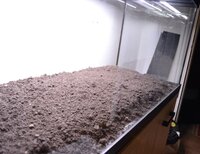
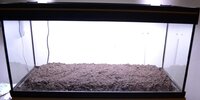
Next up the unipac sand – I chose Maui fine sand.

Now for the hardscape – Two rocks and a bit of wood.

And finally with all the plants.
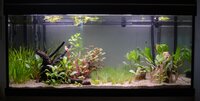
The tank is still cycling so no fish or shrimp just yet. I’m excited and nervous all at the same time. I just hope some of the plants take and start to thrive. I’ll try to update every 3 weeks or so dependent on my free time. So let’s see what happens from here…………………….
If you have any advice, comments, ideas or questions just let me know.
Cheers
As I lost all my livestock in my previous set up, I completely stripped down my tank and cleaned everything thoroughly. A blank canvas…………….
I will be working towards establishing a low maintenance system incorporating some of the ideas on this forum (especially from Troi’s post), Diana Walstad (I’ve just read her excellent book – Ecology of the Planted Aquarium) and Tom Barr’s EI dosing method.
Aquarium Parameters
Volume: 150 litres (~ 40 US gallons)
Temperature: 22degC – Lower temp should increase CO2 solubility
Filtration: 1 x external filter (Aquamanta EFX200)
Lighting: 2 x T5 HO 39W without reflectors
Photoperiod: 4.5-3-4.5 siesta regime (4.5 hours on - 3 hours off - 4.5 hours on).
Substrate: Westland top soil : John Innes No3 – 2:1 ratio topped with Unipac sand. The soil layer is approx 1 in deep and the sand layer is approx 0.5 – 1 in deep.
Fertiliser: Low tech EI
Here's the soil I used

Aquarium Maintenance
My plan is to change approximately 20% of the water every month. I will set this water at a specific GH and alkalinity (more on that below)
Tap Water Quality
I live in Sheffield and we have very soft water with a low nitrate concentration.
pH 7 - 8
Calcium 5.45 ppm
Magnesium 2.4 ppm
Sodium 28.2 ppm
Iron 20 ppb
Nitrate 2.2 ppm
Nitrite 9 ppb
Copper 20 ppb
Sulphate 52 ppm
Total Hardness 9.5 ppm
As you can see from the figures the total hardness is 9.5 ppm (~1.3 dGH) which means the water is very soft and has low carbonate buffering capacity. In my previous set up I did notice melting in some of the plant species and I think this may have been partially attributable to the fact that the levels of Ca and Mg were very low – I also think I was starving the plants.
I will adjust the GH of the water by approximately 6 dGH using a mixture of calcium chloride and magnesium sulphate in a 4:1 ratio.
I also plan to increase the alkalinity by adding 1 dKH equivalent as potassium bicarbonate. This will also serve to add potassium to the aquarium.
Every time I perform a water change I’ll adjust the GH and alkalinity to match that described above. Assuming that the fish food will not add a large amount of nutrients (such as K, Mg) to the water column then I don’t think I’ll get accumulation but we’ll see.
EI Dosing Plan
After reading a lot on here and on thebarrreport.com I’ll be initially aiming for the following concentrations of nutrients dosed once a week based on a 10:1 dosing ratio for CO2:Non CO2 tanks.
Nitrate 2 ppm
Phosphate 0.3 ppm
Potassium 0.6 ppm - concentration will be dictated by addition of potassium nitrate and potassium phosphate (potassium will be added through potassium bicarbonate)
Iron 0.05 ppm – the concentration of all the other trace elements in the mix will be relative to the iron concentration.
As I currently have no fish in the tank I’m going to triple the dosing until the tank is stocked.
Plants
Pistia Stratiotes
Limnobium laeviatum
Alternanthera reineckii 'Rosanervig'
Bacopa caroliniana
Cryptocoryne Wendii
Echinodorus blaheri
Eleocharis Parvula
Ludwigia Repens 'rubin'
Hygrophila Siamensis
Vallisneria Natans
Egeria Densa
Some pictures of the tank set up:
In with the muck.


Next up the unipac sand – I chose Maui fine sand.

Now for the hardscape – Two rocks and a bit of wood.

And finally with all the plants.

The tank is still cycling so no fish or shrimp just yet. I’m excited and nervous all at the same time. I just hope some of the plants take and start to thrive. I’ll try to update every 3 weeks or so dependent on my free time. So let’s see what happens from here…………………….
If you have any advice, comments, ideas or questions just let me know.
Cheers


 .
.
